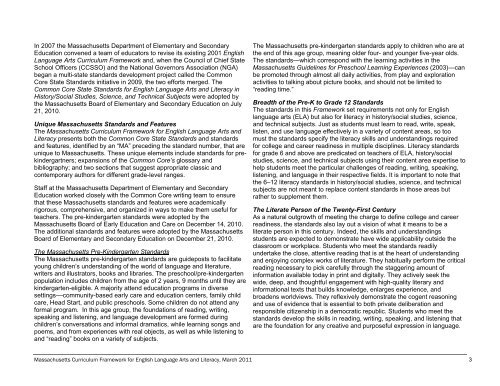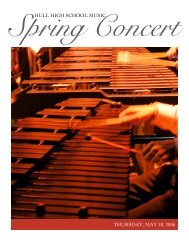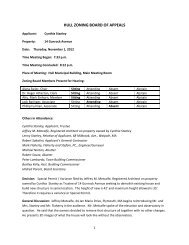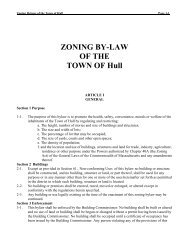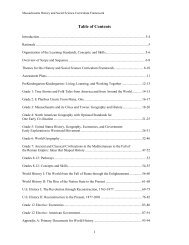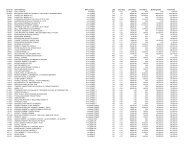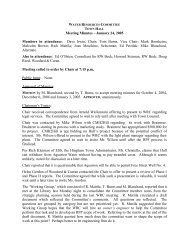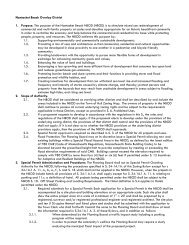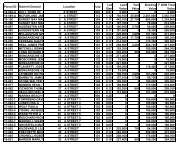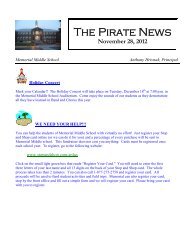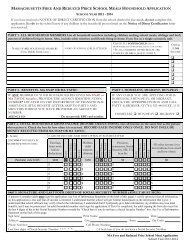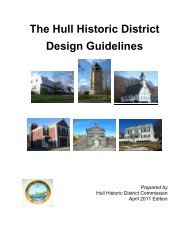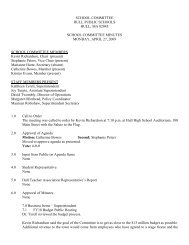Massachusetts Curriculum Framework for English Language Arts ...
Massachusetts Curriculum Framework for English Language Arts ...
Massachusetts Curriculum Framework for English Language Arts ...
- No tags were found...
Create successful ePaper yourself
Turn your PDF publications into a flip-book with our unique Google optimized e-Paper software.
In 2007 the <strong>Massachusetts</strong> Department of Elementary and Secondary<br />
Education convened a team of educators to revise its existing 2001 <strong>English</strong><br />
<strong>Language</strong> <strong>Arts</strong> <strong>Curriculum</strong> <strong>Framework</strong> and, when the Council of Chief State<br />
School Officers (CCSSO) and the National Governors Association (NGA)<br />
began a multi-state standards development project called the Common<br />
Core State Standards initiative in 2009, the two ef<strong>for</strong>ts merged. The<br />
Common Core State Standards <strong>for</strong> <strong>English</strong> <strong>Language</strong> <strong>Arts</strong> and Literacy in<br />
History/Social Studies, Science, and Technical Subjects were adopted by<br />
the <strong>Massachusetts</strong> Board of Elementary and Secondary Education on July<br />
21, 2010.<br />
Unique <strong>Massachusetts</strong> Standards and Features<br />
The <strong>Massachusetts</strong> <strong>Curriculum</strong> <strong>Framework</strong> <strong>for</strong> <strong>English</strong> <strong>Language</strong> <strong>Arts</strong> and<br />
Literacy presents both the Common Core State Standards and standards<br />
and features, identified by an “MA” preceding the standard number, that are<br />
unique to <strong>Massachusetts</strong>. These unique elements include standards <strong>for</strong> prekindergartners;<br />
expansions of the Common Core’s glossary and<br />
bibliography; and two sections that suggest appropriate classic and<br />
contemporary authors <strong>for</strong> different grade-level ranges.<br />
Staff at the <strong>Massachusetts</strong> Department of Elementary and Secondary<br />
Education worked closely with the Common Core writing team to ensure<br />
that these <strong>Massachusetts</strong> standards and features were academically<br />
rigorous, comprehensive, and organized in ways to make them useful <strong>for</strong><br />
teachers. The pre-kindergarten standards were adopted by the<br />
<strong>Massachusetts</strong> Board of Early Education and Care on December 14, 2010.<br />
The additional standards and features were adopted by the <strong>Massachusetts</strong><br />
Board of Elementary and Secondary Education on December 21, 2010.<br />
The <strong>Massachusetts</strong> Pre-Kindergarten Standards<br />
The <strong>Massachusetts</strong> pre-kindergarten standards are guideposts to facilitate<br />
young children’s understanding of the world of language and literature,<br />
writers and illustrators, books and libraries. The preschool/pre-kindergarten<br />
population includes children from the age of 2 years, 9 months until they are<br />
kindergarten-eligible. A majority attend education programs in diverse<br />
settings––community-based early care and education centers, family child<br />
care, Head Start, and public preschools. Some children do not attend any<br />
<strong>for</strong>mal program. In this age group, the foundations of reading, writing,<br />
speaking and listening, and language development are <strong>for</strong>med during<br />
children’s conversations and in<strong>for</strong>mal dramatics, while learning songs and<br />
poems, and from experiences with real objects, as well as while listening to<br />
and “reading” books on a variety of subjects.<br />
The <strong>Massachusetts</strong> pre-kindergarten standards apply to children who are at<br />
the end of this age group, meaning older four- and younger five-year olds.<br />
The standards—which correspond with the learning activities in the<br />
<strong>Massachusetts</strong> Guidelines <strong>for</strong> Preschool Learning Experiences (2003)—can<br />
be promoted through almost all daily activities, from play and exploration<br />
activities to talking about picture books, and should not be limited to<br />
“reading time.”<br />
Breadth of the Pre-K to Grade 12 Standards<br />
The standards in this <strong>Framework</strong> set requirements not only <strong>for</strong> <strong>English</strong><br />
language arts (ELA) but also <strong>for</strong> literacy in history/social studies, science,<br />
and technical subjects. Just as students must learn to read, write, speak,<br />
listen, and use language effectively in a variety of content areas, so too<br />
must the standards specify the literacy skills and understandings required<br />
<strong>for</strong> college and career readiness in multiple disciplines. Literacy standards<br />
<strong>for</strong> grade 6 and above are predicated on teachers of ELA, history/social<br />
studies, science, and technical subjects using their content area expertise to<br />
help students meet the particular challenges of reading, writing, speaking,<br />
listening, and language in their respective fields. It is important to note that<br />
the 6–12 literacy standards in history/social studies, science, and technical<br />
subjects are not meant to replace content standards in those areas but<br />
rather to supplement them.<br />
The Literate Person of the Twenty-First Century<br />
As a natural outgrowth of meeting the charge to define college and career<br />
readiness, the standards also lay out a vision of what it means to be a<br />
literate person in this century. Indeed, the skills and understandings<br />
students are expected to demonstrate have wide applicability outside the<br />
classroom or workplace. Students who meet the standards readily<br />
undertake the close, attentive reading that is at the heart of understanding<br />
and enjoying complex works of literature. They habitually per<strong>for</strong>m the critical<br />
reading necessary to pick carefully through the staggering amount of<br />
in<strong>for</strong>mation available today in print and digitally. They actively seek the<br />
wide, deep, and thoughtful engagement with high-quality literary and<br />
in<strong>for</strong>mational texts that builds knowledge, enlarges experience, and<br />
broadens worldviews. They reflexively demonstrate the cogent reasoning<br />
and use of evidence that is essential to both private deliberation and<br />
responsible citizenship in a democratic republic. Students who meet the<br />
standards develop the skills in reading, writing, speaking, and listening that<br />
are the foundation <strong>for</strong> any creative and purposeful expression in language.<br />
<strong>Massachusetts</strong> <strong>Curriculum</strong> <strong>Framework</strong> <strong>for</strong> <strong>English</strong> <strong>Language</strong> <strong>Arts</strong> and Literacy, March 2011 3


